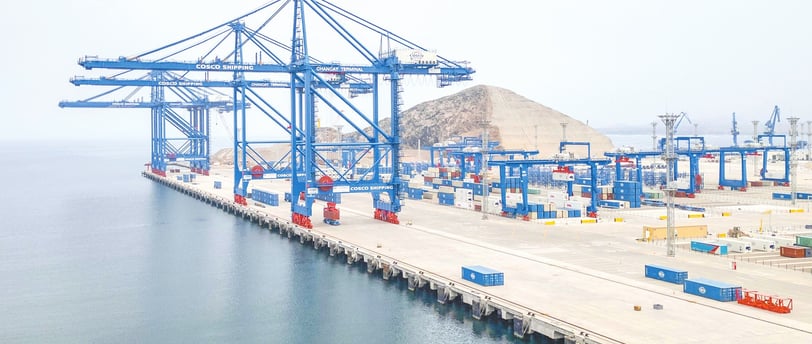The New Contender: How Peru’s Megaport Challenges U.S. Ports in the Global Shipping Arena
11/18/20243 min read


The New Contender: How Peru’s Megaport Challenges U.S. Ports in the Global Shipping Arena
In a world increasingly driven by trade and globalization, the efficiency of ports has become a critical determinant of economic success. Peru’s recent unveiling of a $1.3 billion megaport, designed to handle ultra-large containerships (ULCVs) exceeding 18,000 TEUs, is a game-changing development. As this port begins operations, it is set to challenge the United States’ ports in terms of capacity, efficiency, and strategic importance.
Let’s explore how Peru’s mega port compares with the top U.S. ports and what this means for global shipping.
A Tale of Two Port Systems
Capacity: One Port vs. Three
Peru’s mega port, located near Lima, boasts 15 deepwater berths capable of handling multiple ULCVs simultaneously. These vessels, carrying over 18,000 TEUs each, represent the pinnacle of shipping efficiency. In contrast, the largest U.S. ports, such as Los Angeles and Long Beach, often require 2-3 facilities to manage the same volume due to limitations in infrastructure and berth availability.
For example:
- The Port of Los Angeles, the busiest in the U.S., handled 9.9 million TEUs in 2022. However, its inability to efficiently handle ULCVs creates bottlenecks, especially during peak seasons.
- Peru’s new port is built with modern equipment and infrastructure, enabling faster turnaround times and less congestion.
Speed and Efficiency
The Peruvian mega port’s state-of-the-art systems allow for rapid unloading of ULCVs. These ships can unload their 18,000+ TEUs efficiently, thanks to advanced automation and deep berths. In the U.S., many ports are still transitioning to automation, which leads to slower operations and increased delays during periods of high demand.
Strategic Positioning: Peru’s Geopolitical Advantage
Peru’s location makes it a strategic hub for trade between Asia, South America, and North America. The megaport offers new transshipment opportunities:
- Cargo from Asia can bypass congested U.S. West Coast ports, such as Los Angeles, and instead offload in Peru for redistribution to the Americas.
- Goods destined for the U.S. East and Gulf Coasts can be transshipped through the Panama Canal or smaller vessels, reducing costs and avoiding delays.
This positioning not only benefits South America but also gives global shippers an attractive alternative to traditional routes through the U.S.
Modernization Gap: The U.S. Challenge
U.S. ports face significant challenges in keeping up with new global standards:
- Dredging Limitations: Many U.S. ports cannot accommodate the depth required for ULCVs.
- Aging Infrastructure: Cranes, berths, and container yards require upgrades to handle larger vessels and higher volumes.
- Congestion Issues: Ports like Los Angeles and Long Beach regularly experience congestion, delaying shipments and increasing costs.
While the U.S. has made efforts to modernize ports, such as through funding from the Infrastructure Investment and Jobs Act, progress is slow compared to the rapid development in emerging markets like Peru.
The Bigger Picture: Peru’s Role in Global Trade
Peru’s mega port is part of China’s Belt and Road Initiative (BRI), which focuses on creating alternative trade routes and enhancing global supply chain resilience. The port’s advanced capabilities and strategic location signal a shift in global shipping dynamics, with South America emerging as a critical player.
The move also highlights China’s commitment to increasing its influence in Latin America, potentially reshaping trade flows and challenging the dominance of traditional hubs like the U.S.
What’s Next for U.S. Ports?
To compete with emerging ports like Peru’s megaport, the U.S. must take decisive action:
1. Invest in Infrastructure: Modernizing berths, cranes, and automation systems is essential.
2. Expand Capacity: Ports must prepare to handle ULCVs and the growing volume of global trade.
3. Enhance Collaboration: Stronger partnerships between ports, shipping lines, and logistics companies can streamline operations and reduce inefficiencies.
The U.S. has the resources and expertise to maintain its position as a global logistics leader, but the clock is ticking.
Conclusion
Peru’s new mega port represents a bold step forward in global shipping. With its ability to handle ULCVs, strategic location, and modern infrastructure, it sets a new benchmark for efficiency and capacity. U.S. ports, while still dominant, must evolve rapidly to stay competitive in this changing landscape.
The rise of Peru’s megaport is a reminder that the global shipping industry is constantly evolving. To thrive, ports worldwide must embrace innovation, invest in infrastructure, and adapt to the demands of an increasingly interconnected world.
